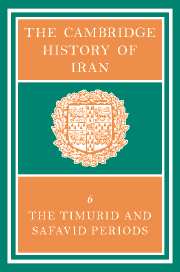Book contents
- Frontmatter
- 1 THE JALAYIRIDS, MUZAFFARIDS AND SARBADĀRS
- 2 TĪMŪR IN IRAN
- 3 THE SUCCESSORS OF TĪMŪR
- 4 THE TÜRKMEN DYNASTIES
- 5 THE SAFAVID PERIOD
- 6 THE SAFAVID ADMINISTRATIVE SYSTEM
- 7 EUROPEAN CONTACTS WITH PERSIA, 1350–1736
- 8 TRADE FROM THE MID-14TH CENTURY TO THE END OF THE SAFAVID PERIOD
- 9 SOCIAL AND INTERNAL ECONOMIC AFFAIRS
- 10 THE EXACT SCIENCES IN TIMURID IRAN
- 11 PERSIAN SCIENCE IN SAFAVID TIMES
- 12 RELIGION IN THE TIMURID AND SAFAVID PERIODS
- 13 SPIRITUAL MOVEMENTS, PHILOSOPHY AND THEOLOGY IN THE SAFAVID PERIOD
- 14 CARPETS AND TEXTILES
- 15 (a) TIMURID ARCHITECTURE
- (b) SAFAVID ARCHITECTURE
- 16 (a) THE PICTORIAL ARTS IN THE TIMURID PERIOD
- (b) THE ARTS IN THE SAFAVID PERIOD
- 17 (a) PERSIAN LITERATURE IN THE TIMURID AND TÜRKMEN PERIODS (782–907/1380–1501)
- (b) HĀFIZ AND HIS CONTEMPORARIES
- (c) PERSIAN LITERATURE IN THE SAFAVID PERIOD
- 18 PERSIAN POETRY IN THE TIMURID AND SAFAVID PERIODS
- Bibliographies
- Plate section
- Plate section
- Plate section
- Maps
- References
5 - THE SAFAVID PERIOD
Published online by Cambridge University Press: 28 March 2008
- Frontmatter
- 1 THE JALAYIRIDS, MUZAFFARIDS AND SARBADĀRS
- 2 TĪMŪR IN IRAN
- 3 THE SUCCESSORS OF TĪMŪR
- 4 THE TÜRKMEN DYNASTIES
- 5 THE SAFAVID PERIOD
- 6 THE SAFAVID ADMINISTRATIVE SYSTEM
- 7 EUROPEAN CONTACTS WITH PERSIA, 1350–1736
- 8 TRADE FROM THE MID-14TH CENTURY TO THE END OF THE SAFAVID PERIOD
- 9 SOCIAL AND INTERNAL ECONOMIC AFFAIRS
- 10 THE EXACT SCIENCES IN TIMURID IRAN
- 11 PERSIAN SCIENCE IN SAFAVID TIMES
- 12 RELIGION IN THE TIMURID AND SAFAVID PERIODS
- 13 SPIRITUAL MOVEMENTS, PHILOSOPHY AND THEOLOGY IN THE SAFAVID PERIOD
- 14 CARPETS AND TEXTILES
- 15 (a) TIMURID ARCHITECTURE
- (b) SAFAVID ARCHITECTURE
- 16 (a) THE PICTORIAL ARTS IN THE TIMURID PERIOD
- (b) THE ARTS IN THE SAFAVID PERIOD
- 17 (a) PERSIAN LITERATURE IN THE TIMURID AND TÜRKMEN PERIODS (782–907/1380–1501)
- (b) HĀFIZ AND HIS CONTEMPORARIES
- (c) PERSIAN LITERATURE IN THE SAFAVID PERIOD
- 18 PERSIAN POETRY IN THE TIMURID AND SAFAVID PERIODS
- Bibliographies
- Plate section
- Plate section
- Plate section
- Maps
- References
Summary
In the summer of 906–7/1501, after his victory over the Āq Quyūnlū, Ismā' īl entered the Türkmen capital Tabrīz, ascended the throne and took the title of Shah. He thereby founded the rule of the Safavid dynasty in Iran which was to last until 1148/1736. Thus after becoming Grand Master of the Ardabīl order on the death of his brother Sultān 'Alī, he finally attained the political power in pursuit of which his father and grandfather had already lost their lives.
Whether we think of this event as marking the beginning of modern Persian history or not, it certainly heralds a new era. The historical achievement of the Safavids was to establish a strong, enduring state in Iran after centuries of foreign rule and a lengthy period of political fragmentation. Although the preceding Türkmen dynasties, the Qarā Quyūnlū and the Āq Quyūnlū, created certain preconditions of this achievement and on the surface pursued similar aims for a short time – came near, indeed, to realising them – their success was only temporary. Despite all their military and political attainments in the late 8th/14th and 9th/15th centuries – for example, the way in which they maintained their independence vis-à-vis such powerful neighbours as the Ottomans, the Mamlūks and the Timurids, or founded new states culminating in the kingdoms of Jahān Shāh and Uzun Hasan – not one of their rulers succeeded in establishing a lasting political structure. Though their rule extended deep into Persian territory, it represents from the point of view of the history of Persia merely peripheral formations beyond or on the frontiers of Iran. Not until the Safavid era did Iran witness the rise of a state similar in importance to the Ottoman empire or the empire of the Egyptian Mamlūks. For more than two centuries the Safavid kingdom prolonged the older political and cultural tradition of Persia and endowed the country and its peoples with a unique character of historic significance, which has in part endured even up to the present day. Its typical features include the revival of the monarchist tradition, the acquisition of historically justified territory, the creation of a new military and political structure, the spread of a Shī' ī creed as the state religion, the Iranicisation of Persian Islam, the continued progress of modern Persian towards becoming the language of politics and administration in modern Iranian history, and the development of a specific culture which reached its peak in architecture (still visible today), but which also produced remarkable results in the intellectual life of the Persian nation.
- Type
- Chapter
- Information
- The Cambridge History of Iran , pp. 189 - 350Publisher: Cambridge University PressPrint publication year: 1986
References
- 23
- Cited by

